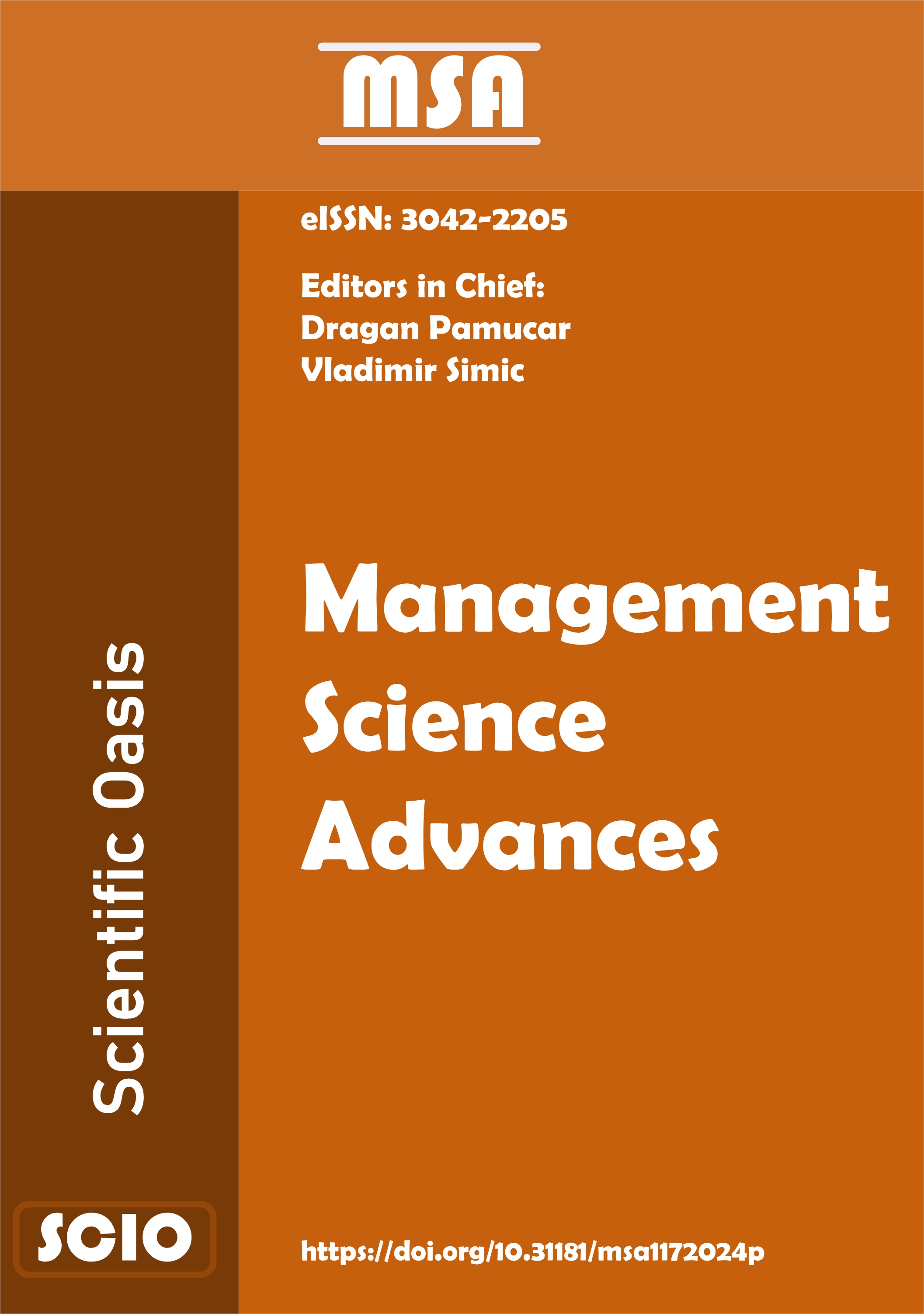Evaluating Medical College Projects with Hamacher Aggregation Operators under the Interval-valued Complex T-Spherical Fuzzy Environment
DOI:
https://doi.org/10.31181/msa21202511Keywords:
Complex Interval-Value T-Spherical Fuzzy Sets, Aggregation Operators, Hamacher Operations, Decision-MakingAbstract
The study explores the utilization of Hamacher aggregation operators (HAOs) in inscription selection for medical health projects. We employ interval-valued complex T-spherical fuzzy (IVCTSF) information to address the inherent uncertainties in healthcare data. In this paper, we develop the multiple-attribute decision-making (MADM) problems with IVCTSF set information. A few HAOs built on IVCTSF sets are presented in this work. We practice the Hamacher t-norm (HTNM) and Hamacher t-conorm (HTCNM) to characterize certain operational Hamacher operational rules within the context of the IVCTSF sets. We utilize averaging and geometric operations to develop a family of operators for aggregating IVCTSF information, namely IVCTSF Hamacher weighted averaging (IVCTFHWA), IVCTSF Hamacher order weighted averaging (IVCTSFHOWA), IVCTSF Hamacher hybrid weighted averaging (IVCTSFHHWA), IVCTSF Hamacher weighted geometric (IVCTSFHWG), IVCTSF Hamacher ordered weighted geometric (IVCTSFHOWG), and IVCTSF Hamacher hybrid weighted geometric (IVCTSFHHWG) operators. Several noteworthy properties of the developed operators are examined. Besides, an approach to the MADM algorithm is formulated using the proposed operators and is applied to a detailed case study. The case study measures the effectiveness of the proposed algorithm, analyzes the effect of variable parameters on the decision-making procedure, and ensures the stability of ranking results. A comparative analysis is conducted against existing studies to underscore the significance and advantages. Our findings demonstrate the effectiveness of this approach in improving decision-making for healthcare management in complex scenarios.
Downloads
References
Atanassov, K., & G. Gargov, G. (1989). Interval valued intuitionistic fuzzy sets. Fuzzy Sets and Systems, 31(3), 343-349. DOI: https://doi.org/10.1016/0165-0114(89)90205-4
Yager, R. (2013). Pythagorean fuzzy subsets. In: 2013 Joint IFSA World Congress and NAFIPS Annual Meeting (IFSA/NAFIPS). https://10.1109/IFSA-NAFIPS.2013.6608375. DOI: https://doi.org/10.1109/IFSA-NAFIPS.2013.6608375
Yager, R.R. (2016). Generalized orthopair fuzzy sets. IEEE Transactions on Fuzzy Systems, 25(5), 1222-1230. DOI: https://doi.org/10.1109/TFUZZ.2016.2604005
Cuong, B.C. (2015). Picture fuzzy sets. JCC, 30(4), 409. DOI: https://doi.org/10.15625/1813-9663/30/4/5032
Mahmood, T., Ullah, K., Khan, Q., & Jan, N. (2019). An approach toward decision-making and medical diagnosis problems using the concept of spherical fuzzy sets. Neural Computing and Applications, 31, 7041-7053. DOI: https://doi.org/10.1007/s00521-018-3521-2
Ramot, D., Milo, R., Friedman, M., & Kandel, A. (2002). Complex fuzzy sets. IEEE Transactions on Fuzzy Systems, 10(2), 171-186. DOI: https://doi.org/10.1109/91.995119
Alkouri, A.M.D.J.S., & Salleh, A.R. (2012). Complex intuitionistic fuzzy sets. AIP Conference Proceedings, 1482(1), 464-470. American Institute of Physics. DOI: https://doi.org/10.1063/1.4757515
Ullah, K., Mahmood, T., Ali, Z., & Jan, N. (2020). On some distance measures of complex Pythagorean fuzzy sets and their applications in pattern recognition. Complex & Intelligent Systems, 6, 15-27. DOI: https://doi.org/10.1007/s40747-019-0103-6
Khan, Q., Khattak, H., AlZubi, A.A., & Alanazi, J.M. (2022). Multiple Attribute Group Decision‐Making Based on Intuitionistic Fuzzy Schweizer‐Sklar Generalized Power Aggregation Operators. Mathematical Problems in Engineering, 2022(1), 4634411. DOI: https://doi.org/10.1155/2022/4634411
Liu, P., & Wang, P. (2018). Some q-rung orthopair fuzzy aggregation operators and their applications to multiple-attribute decision making. International Journal of Intelligent Systems, 33(2), 259-280. DOI: https://doi.org/10.1002/int.21927
Wang, J., Wei, G., Wang, R., Alsaadi, F. E., Hayat, T., Wei, C., et al. (2019). Some q‐rung interval‐valued orthopair fuzzy Maclaurin symmetric mean operators and their applications to multiple attribute group decision making. International Journal of Intelligent Systems, 34(11), 2769-2806. https://10.1002/int.22156. DOI: https://doi.org/10.1002/int.22156
Garg, H. (2017). Some picture fuzzy aggregation operators and their applications to multicriteria decision-making. Arabian Journal for Science and Engineering, 42(12), 5275-5290. https://doi.org/10.1007/s13369-017-2625-9. DOI: https://doi.org/10.1007/s13369-017-2625-9
Zhou, L., Chen, H., & Liu, J. (2012). Generalized power aggregation operators and their applications in group decision making. Computers & Industrial Engineering, 62(4), 989-999. https://doi.org/10.1016/j.cie.2011.12.025. DOI: https://doi.org/10.1016/j.cie.2011.12.025
Gul, R., & Sarfraz, M. (2025). Enhancing Artificial Intelligence Models with Interval-Valued Picture Fuzzy Sets and Sugeno-Weber Triangular Norms. Spectrum of Engineering and Management Sciences, 3(1), 126-146. https://doi.org/10.31181/sems31202540g. DOI: https://doi.org/10.31181/sems31202540g
Darvesh, A., Naeem, K., & Shah, S. B. H. (2025). Scrutiny of Neutrosophic Cubic Fuzzy Data with Different Parametric Values using Bonferroni Weighted Mean: A Robust MCDM Approach. Decision Making Advances, 3(1), 245-265. https://doi.org/10.31181/dma31202576. DOI: https://doi.org/10.31181/dma31202576
Ullah, F., & Waqar Shah, S. (2024). Optimizing Multi-attributive Decision-making: A Novel Approach through Matrix Theory and Fuzzy Hypersoft Sets. Spectrum of Engineering and Management Sciences, 2(1), 100-109. https://doi.org/10.31181/sems2120248r. DOI: https://doi.org/10.31181/sems2120248r
Klement, E.P., Mesiar, R., & Pap, E. (2004). Triangular norms. Position paper III: continuous t-norms. Fuzzy Sets and Systems, 145(3), 439-454. DOI: https://doi.org/10.1016/S0165-0114(03)00304-X
Wu, L., Wei, G., Gao, H., & Wei, Y. (2018). Some interval-valued intuitionistic fuzzy Dombi Hamy mean operators and their application for evaluating the elderly tourism service quality in tourism destination. Mathematics, 6(12), 294. https://10.3390/math6120294. DOI: https://doi.org/10.3390/math6120294
Akram, M., Dudek, W.A., & Dar, J.M. (2019). Pythagorean Dombi fuzzy aggregation operators with application in multicriteria decision‐making. International Journal of Intelligent Systems, 34(11), 3000-3019. DOI: https://doi.org/10.1002/int.22183
Wang, W., & Liu, X. (2011). Intuitionistic fuzzy geometric aggregation operators based on Einstein operations. International Journal of Intelligent Systems, 26(11), 1049-1075. DOI: https://doi.org/10.1002/int.20498
Riaz, M., Athar Farid, H. M., Kalsoom, H., Pamučar, D., & Chu, Y. M. (2020). A robust q-rung orthopair fuzzy Einstein prioritized aggregation operators with application towards MCGDM. Symmetry, 12(6), 1058. DOI: https://doi.org/10.3390/sym12061058
Fahmi, A., Amin, F., Abdullah, S., & Ali, A. (2018). Cubic fuzzy Einstein aggregation operators and its application to decision-making. International Journal of Systems Science, 49(11), 2385-2397. https://10.1080/00207721.2018.1503356. DOI: https://doi.org/10.1080/00207721.2018.1503356
Senapati, T., Chen, G., & Yager, R. R. (2022). Aczel–Alsina aggregation operators and their application to intuitionistic fuzzy multiple attribute decision making. International Journal of Intelligent Systems, 37(2), 1529-1551. https://10.1002/int.22684. DOI: https://doi.org/10.1002/int.22684
Yang, Y., Chen, Z. S., Chen, Y. H., & Chin, K. S. (2018). Interval-valued Pythagorean fuzzy Frank power aggregation operators based on an isomorphic Frank dual triple. International Journal of Computational Intelligence Systems, 11(1), 1091-1110. https://doi.org/10.2991/ijcis.11.1.83. DOI: https://doi.org/10.2991/ijcis.11.1.83
Jia, Q., Hu, J., & Herrera-Viedma, E. (2021). A Novel Solution for $ Z $-Numbers Based on Complex Fuzzy Sets and Its Application in Decision-Making System. IEEE Transactions on Fuzzy Systems, 30(10), 4102-4114. https://10.1109/TFUZZ.2021.3138649. DOI: https://doi.org/10.1109/TFUZZ.2021.3138649
Wang, W., & Liu, X. (2012). Intuitionistic fuzzy information aggregation using Einstein operations. IEEE Transactions on Fuzzy Systems, 20(5), 923-938. https://10.1109/TFUZZ.2012.2189405. DOI: https://doi.org/10.1109/TFUZZ.2012.2189405
Klement, E.P., Mesiar, R., & Pap, E. (2004). Triangular norms. Position paper II: general constructions and parameterized families. Fuzzy Sets and Systems, 145(3), 411-438. DOI: https://doi.org/10.1016/S0165-0114(03)00327-0
Garg, H. (2019). Intuitionistic fuzzy hamacher aggregation operators with entropy weight and their applications to multi-criteria decision-making problems. Iranian Journal of Science and Technology, Transactions of Electrical Engineering, 43(3), 597-613. DOI: https://doi.org/10.1007/s40998-018-0167-0
Wu, S.-J., & Wei, G.-W. (2017). Pythagorean fuzzy Hamacher aggregation operators and their application to multiple attribute decision making. International Journal of Knowledge-based and Intelligent Engineering Systems, 21(3), 189-201. https://10.1016/S0165-0114(98)00167-5. DOI: https://doi.org/10.3233/KES-170363
Darko, A.P., & Liang, D. (2020). Some q-rung orthopair fuzzy Hamacher aggregation operators and their application to multiple attribute group decision making with modified EDAS method. Engineering Applications of Artificial Intelligence, 87, 103259. https://doi.org/10.1016/j.engappai.2019.103259. DOI: https://doi.org/10.1016/j.engappai.2019.103259
Ullah, K., Mahmood, T., & Garg, H. (2020). Evaluation of the performance of search and rescue robots using T-spherical fuzzy Hamacher aggregation operators. International Journal of Fuzzy Systems, 22(2), 570-582. https://10.1007/s40815-020-00803-2. DOI: https://doi.org/10.1007/s40815-020-00803-2
Xu, Y., & Wang, H. (2012). The induced generalized aggregation operators for intuitionistic fuzzy sets and their application in group decision making. Applied Soft Computing, 12(3), 1168-1179. https://10.1016/j.asoc.2011.11.003. DOI: https://doi.org/10.1016/j.asoc.2011.11.003
Wei, G., & Lu, M.A.O. (2017). Dual hesitant Pythagorean fuzzy Hamacher aggregation operators in multiple attribute decision making. Archives of Control Sciences, 27(3), 365-395. https://10.1515/acsc-2017-0024. DOI: https://doi.org/10.1515/acsc-2017-0024
Ali, Z., Mahmood, T., Ullah, K., & Khan, Q. (2021). Einstein geometric aggregation operators using a novel complex interval-valued pythagorean fuzzy setting with application in green supplier chain management. Reports in Mechanical Engineering, 2(1), 105-134. https://10.31181/rme2001020105t. DOI: https://doi.org/10.31181/rme2001020105t
Klement, E.P., & Navara, M. (1999). A survey on different triangular norm-based fuzzy logics. Fuzzy Sets and Systems, 101(2), 241-251. https://10.1016/S0165-0114(98)00167-5. DOI: https://doi.org/10.1016/S0165-0114(98)00167-5
Ali, Z., Mahmood, T., & Yang, M. S. (2020). Complex T-spherical fuzzy aggregation operators with application to multi-attribute decision making. Symmetry, 12(8), 1311. https://doi.org/10.3390/sym12081311. DOI: https://doi.org/10.3390/sym12081311
Downloads
Published
Issue
Section
License
Copyright (c) 2025 Mehwish Sarfraz, Rizwan Gul (Author)

This work is licensed under a Creative Commons Attribution 4.0 International License.













